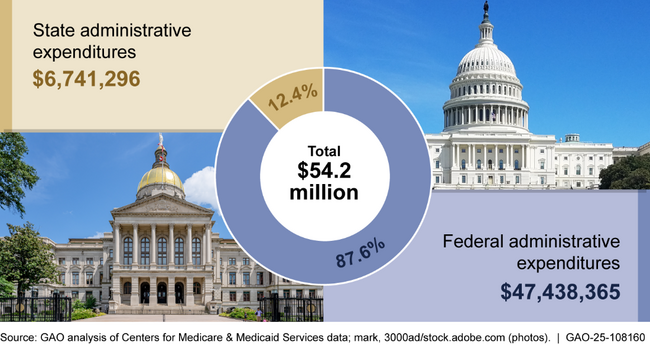Medicaid Demonstrations: Information on Administrative Spending for Georgia Work Requirements
Fast Facts
In 2023, Georgia began requiring some Medicaid beneficiaries to work or engage in other activities like vocational training to keep their Medicaid coverage. The new requirements necessitated changes to the state’s eligibility and enrollment system, outreach efforts, and other administrative activities.
To make these administrative changes, the state spent $54.2 million between October 2020 and March 2025. Most of these funds—$47.4 million—came from the federal government. We found weaknesses in federal oversight of this spending. These findings are consistent with concerns we raised in our 2019 report.

Highlights
What GAO Found
Medicaid section 1115 demonstrations enable states to test new approaches to providing Medicaid coverage and services. In October 2020, the Centers for Medicare & Medicaid Services (CMS) approved Georgia’s demonstration that expanded coverage of the adult population contingent on individuals meeting requirements to work or participate in other activities, such as training. Under the demonstration, individuals must meet these work requirements as part of the initial eligibility determination and through monthly reporting. After a 2-year delay while litigation related to the demonstration was pending, Georgia opened enrollment for the demonstration in July 2023.
Implementing the demonstration required a number of changes to the state’s eligibility and enrollment systems, additional outreach efforts, and other administrative activities. Administrative spending for the demonstration was $54.2 million out of the $80.3 million in total demonstration spending in the first 4.5 years, according to data reported by Georgia to CMS. The majority of the administrative spending ($47.4 million or about 88 percent) was financed by federal dollars. The federal government generally provides 50 percent of the funds for administrative activities (referred to as a 50 percent matching rate), but pays for up to 90 percent of certain administrative costs, including for IT system changes.
Reported Administrative Expenditures Under Georgia’s Medicaid Demonstration, Fiscal Year 2021 Through Second Quarter of Fiscal Year 2025

Notes: Total demonstration spending for this period was $80.3 million. States generally have up to 2 years to report an expenditure, including any prior period adjustments. Data reflect expenditures, including any prior period adjustments, reported as of May 20, 2025.
GAO found weaknesses in CMS’s consideration and oversight of administrative spending.
- No consideration during demonstration approval. CMS did not request and Georgia did not provide estimates of administrative costs during the approval process despite the agency’s policy that Medicaid demonstrations not increase federal spending over what would have been spent absent the demonstration.
- Approved spending at higher federal matching rates than appeared allowable. CMS approved spending for activities such as for monitoring reports, a media strategy, and branding at a 90 percent federal matching rate reserved for developing and implementing changes to IT systems.
These findings are consistent with concerns GAO raised in 2019, which GAO made recommendations to address. GAO found that CMS’s demonstration approval process does not take into account the extent to which demonstrations will increase administrative costs, and that CMS provided federal funds for costs that may not have been allowable or at inappropriately high matching rates. Addressing the latter will become more important as states implement work requirements in response to legislation enacted on July 4, 2025.
Why GAO Did This Study
Section 1115 demonstrations are a significant component of Medicaid spending. In 2018, CMS began allowing states to test work requirements under demonstrations, but most states’ demonstrations were later terminated as a result of litigation or by CMS. The exception was Georgia where work requirements remain in place. Implementing work requirements can involve various administrative activities, with states receiving federal funds for up to 90 percent of spending for certain activities.
GAO was asked to examine the administrative costs of Georgia’s demonstration testing work requirements. This report describes the (1) types and (2) amount of administrative spending for Georgia’s demonstration. It also examines the extent to which CMS considered administrative costs at approval, and the agency’s oversight of administrative spending after approval. GAO reviewed demonstration expenditure data for fiscal year 2021 through the second quarter of fiscal year 2025, demonstration documentation, and past GAO findings and related recommendations. GAO also interviewed officials from CMS and Georgia.
Recommendations
GAO is reiterating previous unimplemented recommendations that CMS (1) account for administrative costs when assessing a demonstration’s effect on federal spending, and (2) assess the risks of providing federal funds that are not allowable to administer work requirements and improve oversight procedures, as warranted. CMS did not agree with these recommendations when we made them in 2019; however, our findings regarding Georgia’s demonstration affirm that action by CMS to address them will better ensure fiscal integrity. CMS reviewed a draft of this report and provided technical comments, which we incorporated as appropriate.
